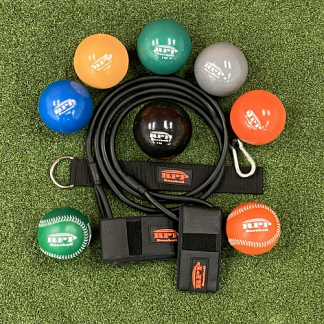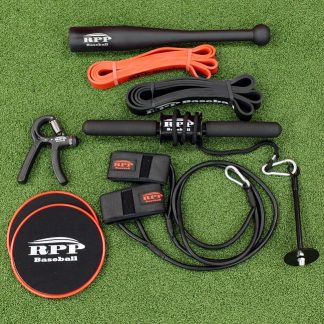Description
Activation bands are designed to be easily transportable to the gym or field. They are primarily used as part of a throwing warm-up to target specific muscles and movements that are key players in the throwing motion and can be taken anywhere.
- Helps activate and balance rotator cuff and surrounding muscles
- Prepares the arm to accelerate/decelerate
- Increases blood flow prior to throwing
Let’s face it, everyone loves to throw hard, but we have to make sure we’re going about it the best and safest way possible. Learning the correct way to take care of your arm, shoulder and body as a pitcher should be a top priority, not only during the season but year-round as well. We utilize band warm-up/activations 2x’s/week to help maintain cuff activation/stability, once high-intent throwing slows down. The first step is correcting poor form, so they don’t continue to “get good at moving poorly”.
In addition, over the years many college coaches have complained to me about how poor band-work looks on their fields. Many even have suggested “please write a blog about this!”. Unfortunately, I know. I have seen it for myself. Here are two main points that I see that causes band work to get “ugly”.
More is Not Better
Many people use an excessive amount of repetitions looking for that “burn” that is associated with strength training. The problem is, during the in-season, throwing is strength training for the cuff, so too much band work can put a shoulder into the 3rd inning before you’ve even thrown a single pitch! On the contrary I use a bit more volume in the off-season (two sets instead of one), but I do not recommend it as a substitute for strength training.
Unfortunately, at some point along the way some of the band companies started to market and promote their bands as a strength training tool. Let’s me say this loud and clear…
“Band work is not strength training”
Too Heavy of a Band
Using too heavy of a band resistance when performing band activations can do more harm than good by creating poor movement patterns as well as activating the bigger muscles such as the Latissimus Dorsi (Lat) and the deltoid instead of the smaller stabilizers of the cuff (infraspinatus Teres minor).

The takeaway here is that you want to feel these drills in the posterior cuff, not on the side or front of the shoulder or the lower lumbar for that matter.
We took the average distance that our HS and college guys stood from a wall when performing band work. This was approximately 60-70” (5’0 – 5’10) this was an average range and seems to be where athletes set up regardless of their ability to adequately perform the drills with proper form. I will say that our pro guys and more elite level players- who can actually handle the heavier resistance are actually the guys who immediately reach for the lighter bands. They just know it feels better.
We then measured the lbs of resistance with both a heavy and lighter resistance band. The “heavier” bands have a resistance of (6-7) lbs. when stretched whereas the lighter version such as the bands we use here at RPP had a resistance of (3-4) lbs.
Another takeaway was this… the athletes FELT the activation in the posterior cuff more when using the band with less resistance.
“The athletes FELT the activation in the posterior cuff more when using the band with less resistance”
If a bands resistance is correct the athlete should be able to do two things:
1. Keep the hips, lower lumbar and torso stable in order to help maintain ball and socket congruency…
Lower Half – Unstable
Lower Half – Stable
2. Keeping the elbow still throughout the exercise. This one again helps keep “the ball in the socket” as well as preventing creating downward depression of the scap through excess tugging on the lat.
Elbow – Unstable
Elbow – Stable
The problem is that most athletes being the alpha males that we are, feel once again that “more is better” when it comes to using a heavier band or one with less resistance. While some exercises where the shoulder is in more of a provocative position such as ER at 90 degrees of abduction (seen above), requires less tension, there are cases with some band activations where more tension/resistance is required. How’s this for a great idea.. you can always just back up a bit and increase the tension in the band.
Don’t get me wrong, band work can be great; just make sure you are doing it correctly, and with good form. And remember, let me say this again…
“Band activation is NOT a replacement for strength training”
So, using too heavy of a band is like “throwing the baby out with the bath water”. Try a bit less resistance and see how much your form improves as well as how much more you feel it where you’re supposed to-in the posterior cuff.
Lastly, while there is some degree of strengthening that can be done to the posterior cuff and shoulder in the off season, it is primarily a great way to increase blood flow to the shoulder and activate the primary cuff musculature to help you get ready to throw as well as keep up with arm care and health year-round.






